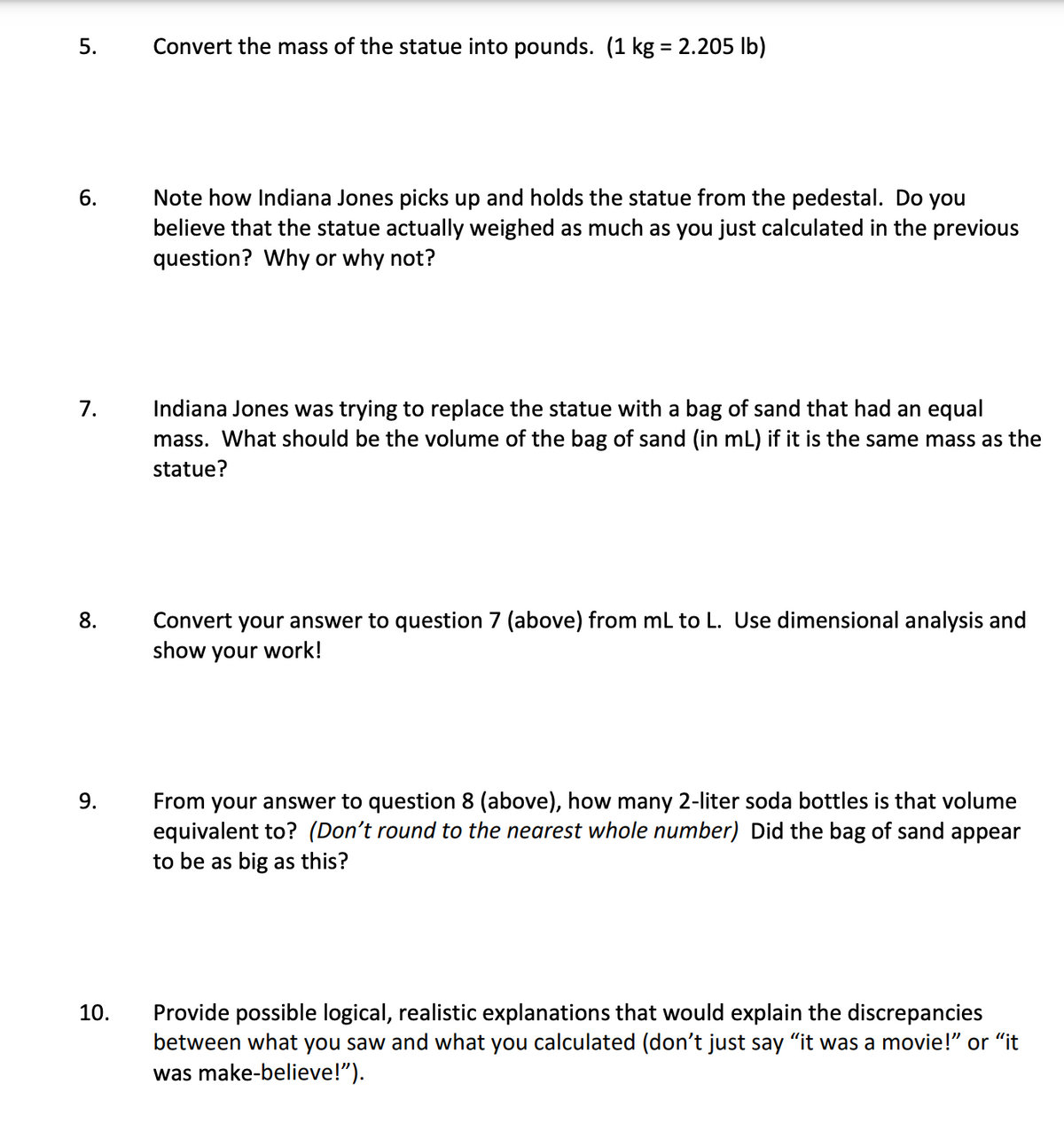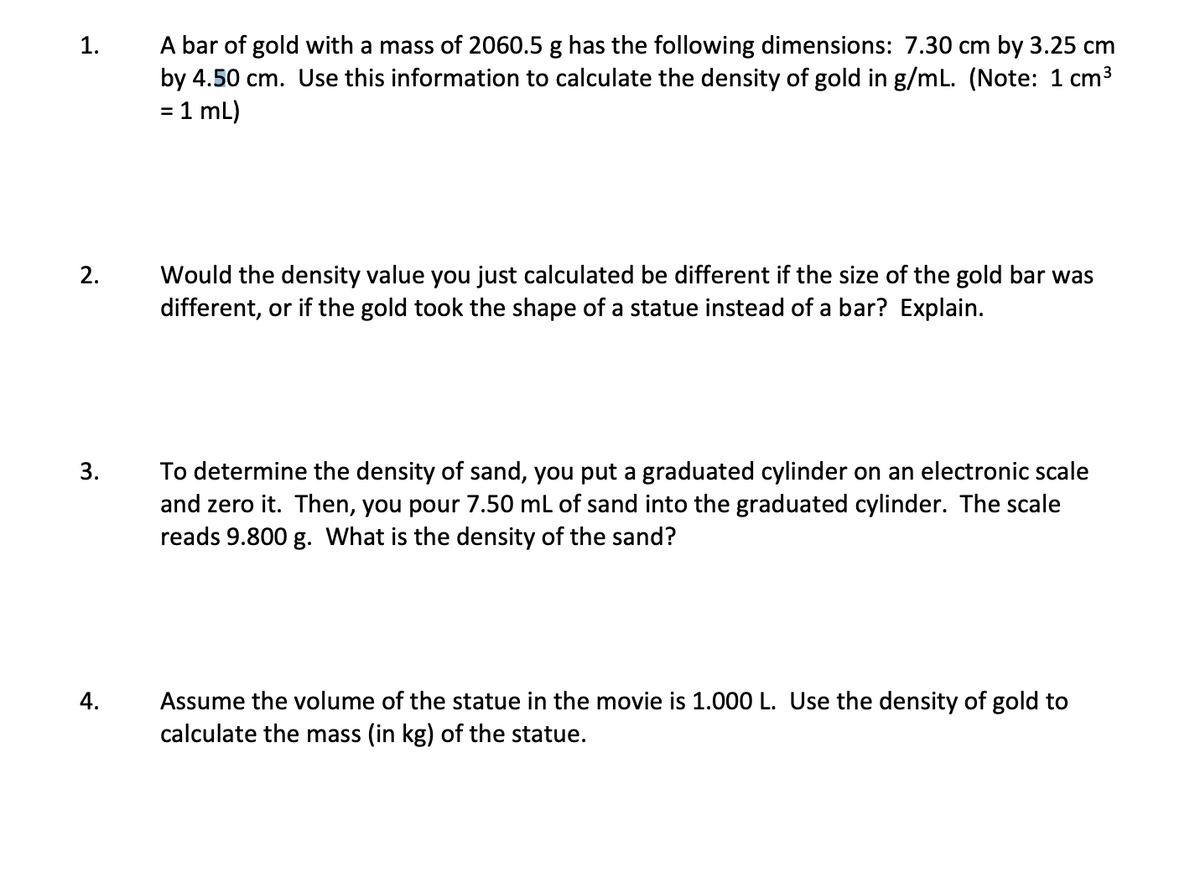A bar of gold with a mass of 2060.5 g has the following dimensions: 7.30 cm by 3.25 cm by 4.50 cm. Use this information to calculate the density of gold in g/mL. (Note: 1 cm3 = 1 mL) 1. 2. Would the density value you just calculated be different if the size of the gold bar was different, or if the gold took the shape of a statue instead of a bar? Explain.
A bar of gold with a mass of 2060.5 g has the following dimensions: 7.30 cm by 3.25 cm by 4.50 cm. Use this information to calculate the density of gold in g/mL. (Note: 1 cm3 = 1 mL) 1. 2. Would the density value you just calculated be different if the size of the gold bar was different, or if the gold took the shape of a statue instead of a bar? Explain.
Chemistry: Principles and Practice
3rd Edition
ISBN:9780534420123
Author:Daniel L. Reger, Scott R. Goode, David W. Ball, Edward Mercer
Publisher:Daniel L. Reger, Scott R. Goode, David W. Ball, Edward Mercer
Chapter1: Introduction To Chemistry
Section: Chapter Questions
Problem 1.97QE: Gold leaf, which is used for many decorative purposes, is made by hammering pure gold into very thin...
Related questions
Question
100%
please help me

Transcribed Image Text:Convert the mass of the statue into pounds. (1 kg = 2.205 Ib)
Note how Indiana Jones picks up and holds the statue from the pedestal. Do you
believe that the statue actually weighed as much as you just calculated in the previous
question? Why or why not?
6.
7.
Indiana Jones was trying to replace the statue with a bag of sand that had an equal
mass. What should be the volume of the bag of sand (in mL) if it is the same mass as the
statue?
Convert your answer to question 7 (above) from ml to L. Use dimensional analysis and
show your work!
8.
From your answer to question 8 (above), how many 2-liter soda bottles is that volume
equivalent to? (Don't round to the nearest whole number) Did the bag of sand appear
to be as big as this?
Provide possible logical, realistic explanations that would explain the discrepancies
between what you saw and what you calculated (don't just say "it was a movie!" or "it
was make-believe!").
10.
5.
9.

Transcribed Image Text:A bar of gold with a mass of 2060.5 g has the following dimensions: 7.30 cm by 3.25 cm
by 4.50 cm. Use this information to calculate the density of gold in g/mL. (Note: 1 cm3
= 1 mL)
1.
Would the density value you just calculated be different if the size of the gold bar was
different, or if the gold took the shape of a statue instead of a bar? Explain.
2.
To determine the density of sand, you put a graduated cylinder on an electronic scale
and zero it. Then, you pour 7.50 mL of sand into the graduated cylinder. The scale
reads 9.800 g. What is the density of the sand?
3.
Assume the volume of the statue in the movie is 1.000 L. Use the density of gold to
calculate the mass (in kg) of the statue.
4.
Expert Solution
This question has been solved!
Explore an expertly crafted, step-by-step solution for a thorough understanding of key concepts.
This is a popular solution!
Trending now
This is a popular solution!
Step by step
Solved in 4 steps

Knowledge Booster
Learn more about
Need a deep-dive on the concept behind this application? Look no further. Learn more about this topic, chemistry and related others by exploring similar questions and additional content below.Recommended textbooks for you

Chemistry: Principles and Practice
Chemistry
ISBN:
9780534420123
Author:
Daniel L. Reger, Scott R. Goode, David W. Ball, Edward Mercer
Publisher:
Cengage Learning

General Chemistry - Standalone book (MindTap Cour…
Chemistry
ISBN:
9781305580343
Author:
Steven D. Gammon, Ebbing, Darrell Ebbing, Steven D., Darrell; Gammon, Darrell Ebbing; Steven D. Gammon, Darrell D.; Gammon, Ebbing; Steven D. Gammon; Darrell
Publisher:
Cengage Learning


Chemistry: Principles and Practice
Chemistry
ISBN:
9780534420123
Author:
Daniel L. Reger, Scott R. Goode, David W. Ball, Edward Mercer
Publisher:
Cengage Learning

General Chemistry - Standalone book (MindTap Cour…
Chemistry
ISBN:
9781305580343
Author:
Steven D. Gammon, Ebbing, Darrell Ebbing, Steven D., Darrell; Gammon, Darrell Ebbing; Steven D. Gammon, Darrell D.; Gammon, Ebbing; Steven D. Gammon; Darrell
Publisher:
Cengage Learning


Chemistry
Chemistry
ISBN:
9781305957404
Author:
Steven S. Zumdahl, Susan A. Zumdahl, Donald J. DeCoste
Publisher:
Cengage Learning

Chemistry: The Molecular Science
Chemistry
ISBN:
9781285199047
Author:
John W. Moore, Conrad L. Stanitski
Publisher:
Cengage Learning

Chemistry & Chemical Reactivity
Chemistry
ISBN:
9781133949640
Author:
John C. Kotz, Paul M. Treichel, John Townsend, David Treichel
Publisher:
Cengage Learning